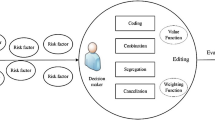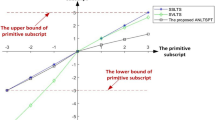Abstract
This paper aims to propose a two-sided matching decision-making approach with the probabilistic linguistic evaluations. Existing two-sided matching decision-making methods rarely consider the psychological behaviors of the subjects, which makes the matching result deviate from the reality. To overcome this drawback, we introduce the prospect theory to describe the perception of the subjects. At first, the probabilistic linguistic evaluations are normalized. Then, the evaluations under the cost criteria are transformed into their benefit types to guarantee the consistency of the computation process. Thereafter, calculate the prospect values for the subjects based on the defined relative normalized Lance distance of the probabilistic linguistic term sets. Afterwards, aggregate the prospect values into the satisfaction degrees. On the basis of this, build the multi-objective two-sided matching decision-making model and further transform it into the single-objective model. To solve the latter is to obtain the optimal matching result. An illustrative example of intelligent technology transfer is presented to validate the proposed approach, and the optimal matching result is obtained for the demanders and the providers. Finally, we demonstrate the advantages of the proposed approach comparing with the existing methods.
Similar content being viewed by others
Explore related subjects
Discover the latest articles, news and stories from top researchers in related subjects.Data availability
Not Applicable.
References
Atanassov KT (1986) Intuitionistic fuzzy sets. Fuzzy Sets Syst 20(1):87–96
Chen SQ, Wang YM, Shi HL, Lin Y, Li MJ (2016a) Two-sided matching decision-making with uncertain information under multiple states. J Syst Sci Inform 4(2):186–194
Chen X, Li ZW, Fan ZP, Zhou XY, Zhang X (2016b) Matching demanders and suppliers in knowledge service: a method based on fuzzy axiomatic design. Inf Sci 346–347:130–145
Chen X, Wang J, Liang HM, Han J (2019) Hesitant multi-attribute two-sided matching: a perspective based on prospect theory. J Intell Fuzzy Syst 36(3):1–16
Chen X, Zhao L, Liang HM, Lai KK (2017) Matching patients and healthcare service providers: a novel two-stage method based on knowledge rules and OWA-NSGA-II algorithm. J Comb Optim 37(1):221–247
Emran SM, Ye N (2002) Robustness of Chi-square and Canberra distance metrics for computer intrusion detection. Qual Reliab Eng Int 18(1):19–28
Fan ZP, Li MY, Zhang X (2017) Satisfied two-sided matching: a method considering elation and disappointment of agents. Soft Comput 22(21):7227–7241
Feng XQ, Liu Q, Wei CP (2019) Probabilistic linguistic QUALIFLEX approach with possibility degree comparison. J Intell Fuzzy Syst 36(1):710–730
Gale D, Shapley LS (1962) College admissions and the stability of marriage. Amer Math Monthly 69(1):9–15
Han J, Li B, Liang HM, Lai KK (2018) A novel two-sided matching decision method for technological knowledge supplier and demander considering the network collaboration effect. Soft Comput 22(16):5439–5451
Herrera F, Martinez L (2000) A 2-tuple fuzzy linguistic representation model for computing with words. IEEE Trans Fuzzy Syst 8(6):746–752
Jia X, Wang XF, Zhu YF, Zhou L, Zhou H (2021) A two-sided matching decision-making approach based on regret theory under intuitionistic fuzzy environment. J Intell Fuzzy Syst 40(6):11491–11508
Jiang ZZ, Fan ZP, Ip WH, Chen XH (2016) Fuzzy multiobjective modeling and optimization for one-shot multiattribute exchanges with indivisible demand. IEEE Trans Fuzzy Syst 24(3):708–723
Jiang ZZ, Zhang RY, Fan ZP, Chen XH (2014) A fuzzy matching model with Hurwicz criteria for one-shot multi-attribute exchanges in E-brokerage. Fuzzy Optim Decis Making 14(1):77–96
Kahneman D, Tversky A (1979) Prospect theory: an analysis of decision under risk. Econometrica 47(2):263–292
Li B, Zhang YX, Xu ZS (2020a) The medical treatment service matching based on the probabilistic linguistic term sets with unknown attribute weights. Int J Fuzzy Syst 22(5):1487–1505
Li B, Xu ZS, Zhang YX (2020b) Two-stage multi-sided matching dispatching models based on improved BPR function with probabilistic linguistic term sets. Int J Mach Learn Cybern 12(1):151–169
Li B, Zhang YX, Xu ZS (2019a) The aviation technology two-sided matching with the expected time based on the probabilistic linguistic preference relations. J Op Res Soc China 8(1):45–77
Li BD, Yang Y, Su JF, Liang ZC, Wang S (2020c) Two-sided matching decision-making model with hesitant fuzzy preference information for configuring cloud manufacturing tasks and resources. J Intell Manuf 31(8):2033–2047
Li MY, Zhao XJ, Fan ZP, Cao PP, Qu XN (2019b) A model for assignment of rescuers considering multiple disaster areas. Int J Disaster Risk Reduct 38:101201
Li P, Wang NN, Wei CP, Zhang N (2020d) A two-sided matching method considering the lowest value of acceptability with regret theory for probabilistic linguistic term sets. Int J Mach Learn Cybern 12(4):917–930
Liang DC, He X, Xu ZS (2020) Multi-attribute dynamic two-sided matching method of talent sharing market in incomplete preference ordinal environment. Appl Soft Comput 93:106427
Liang R, Wu CZ, Sheng ZH, Wang XY (2018) Multi-criterion two-sided matching of public–private partnership infrastructure projects: criteria and methods. Sustainability 10(4):1178–1200
Lin MW, Xu ZS (2017) Probabilistic linguistic distance measures and their applications in multi-criteria group decision making. Soft Comput Appl Group Decis Mak Consens Model 357(2018):411–440
Lin Y, Wang YM, Chen SQ (2016) Hesitant fuzzy multiattribute matching decision making based on regret theory with uncertain weights. Int J Fuzzy Syst 19(4):955–966
Lin Y, Wang YM, Chin KS (2018) An enhanced approach for two-sided matching with 2-tuple linguistic multi-attribute preference. Soft Comput 23(17):7977–7990
Liu Y, Li KW (2017) A two-sided matching decision method for supply and demand of technological knowledge. J Knowl Manag 21(3):592–606
Pang Q, Wang H, Xu ZS (2016) Probabilistic linguistic term sets in multi-attribute group decision making. Inf Sci 369:128–143
Rodriguez RM, Martinez L, Herrera F (2012) Hesitant fuzzy linguistic term sets for decision making. IEEE Trans Fuzzy Syst 20(1):109–119
Sha XY, Yin CC, Xu ZS, Zhang S (2021) Probabilistic hesitant fuzzy TOPSIS emergency decision-making method based on the cumulative prospect theory. J Intell Fuzzy Syst 40(3):4367–4383
Tian XL, Xu ZS, Gu J, Herrera-Viedma E (2018) How to select a promising enterprise for venture capitalists with prospect theory under intuitionistic fuzzy circumstance? Appl Soft Comput 67:756–763
Torra V (2010) Hesitant fuzzy sets. Int J Intell Syst 25(6):529–539
Tversky A (1992) Advances in prospect theory: Cumulative representation of uncertainty. J Risk Uncertain 5(4):297–323
Wang J, Li B, Li W, Yang SL (2018) Two-sided matching model based on cumulative prospect theory for decision making of two-way referral system. J Interdis Math 21(5):1097–1102
Wang PY, Shen J, Zhang B (2016) A new method for two-sided matching decision making of PPP projects based on intuitionistic fuzzy choquet integral. J Intell Fuzzy Syst 31(4):2221–2230
Wang XK, Wang JQ, Zhang HY (2019) Distance-based multicriteria group decision-making approach with probabilistic linguistic term sets. Expert Syst 36(2):1–18
Xu ZS (2012) Linguistic decision making: theory and method. Springer, Berlin
Yang YM, Jia R, Xun H, Yang J, Chen Q, Zeng XG, Yang M (2018) Determining the number of instars in simulium quinquestriatum (Diptera: Simuliidae) using k-means clustering via the Canberra distance. J Med Entomol 55(4):808–816
Yin S, Li BZ (2018) Matching management of supply and demand of green building technologies based on a novel matching method with intuitionistic fuzzy sets. J Clean Prod 201:748–763
Yu DJ, Xu ZS (2019) Intuitionistic fuzzy two-sided matching model and its application to personnel-position matching problems. J Op Res Soc 71(2):312–321
Yue Q, Peng YS, Yu BW, Hong Y, Xiao Q (2015) Two-sided matching decision under multi-granularity uncertain linguistic environment. Int J u- and e-Serv Sci Technol 8(11):35–44
Yue Q, Zhang L, Peng YS, Yu BW, Hong Y, Xiao Q (2016) Decision method for two-sided matching with interval-valued intuitionistic fuzzy sets considering matching aspirations. J Intell Fuzzy Syst 31(6):2903–2910
Yue Q, Zhang LL (2020a) TOPSIS based two-sided matching under interval-valued intuitionistic fuzzy environment in virtual reality technology transfer. IEEE Access 8:101024–101034
Yue Q, Zhang LL (2020b) Two-sided matching for hesitant fuzzy numbers in smart intelligent technique transfer. Mechl Syst Sig Process 139:106643
Yue Q, Zhang LL, Yu BW, Zhang LJ, Zhang JL (2019) Two-sided matching for triangular intuitionistic fuzzy numbers in smart environmental protection. IEEE Access 7:42426–42435
Yue Q (2019) Two-sided matching decision with trapezoidal intuitionistic fuzzy numbers using similarity measures. J Nonlinear Convex Anal 20(6):1017–1026
Zadeh LA (1965) Fuzzy sets. Inf Control 8:338–353
Zadeh LA (1975) The concept of a linguistic variable and its application to approximate reasoning-I. Inf Sci 8(3):199–249
Zhang Z, Gao JL, Gao Y, Yu WY (2021) Two-sided matching decision making with multi-granular hesitant fuzzy linguistic term sets and incomplete criteria weight information. Exp Syst Appl 168:114311
Zhang Z, Kou XY, Palomares I, Yu WY, Gao JL (2019) Stable two-sided matching decision making with incomplete fuzzy preference relations: A disappointment theory based approach. Appl Soft Comput 84:105730
Zhang Z, Kou XY, Yu WY, Gao Y (2020) Consistency improvement for fuzzy preference relations with self-confidence: an application in two-sided matching decision making. J Op Res Soc 72(8):1914–1927
Funding
This work was supported by the National Natural Science Foundation of China under Grant 61773123, 71801090, the Humanities and Social Science Foundation of the Ministry of Education of China under Grant 19YJA630071, and the Key Project of the Philosophy and Social Science Foundation of Hunan Province of China under Grant 18ZDB009.
Author information
Authors and Affiliations
Corresponding author
Ethics declarations
Declaration of Competing Interest
The authors declare that they have no known competing financial interests or personal relationships that could have appeared to influence the work reported in this paper.
Conflict of interest
The authors declare that they have no conflict of interest.
Ethical approval
This article does not contain any studies with human participants or animals performed by any of the authors.
Informed consent
Informed consent was obtained from all individual participants included in this study.
Additional information
Publisher's Note
Springer Nature remains neutral with regard to jurisdictional claims in published maps and institutional affiliations.
Rights and permissions
About this article
Cite this article
Jia, X., Wang, XF., Wang, YM. et al. A two-sided matching decision-making approach based on prospect theory under the probabilistic linguistic environment. Soft Comput 26, 3921–3938 (2022). https://doi.org/10.1007/s00500-022-06737-1
Accepted:
Published:
Issue Date:
DOI: https://doi.org/10.1007/s00500-022-06737-1




